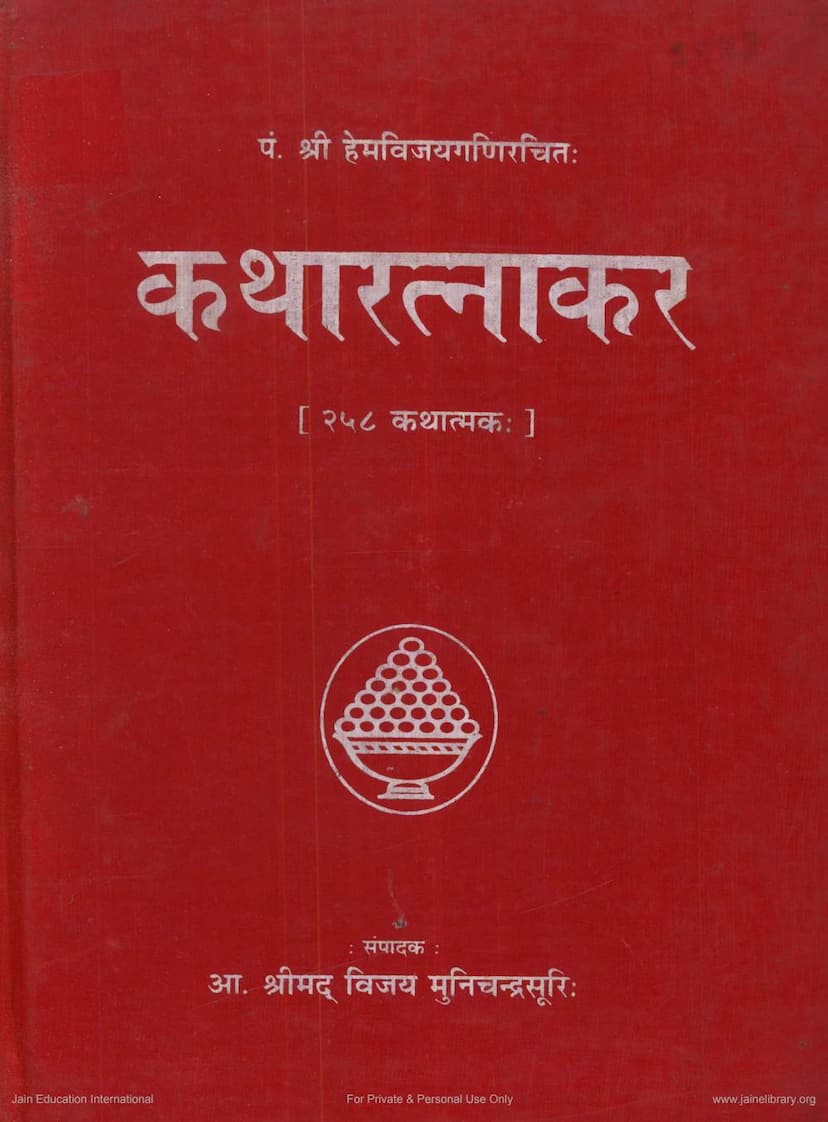Katharatnakar
Added to library: September 2, 2025

Summary
This Jain text, titled Katharatnakar (कथारत्नाकर), is a collection of 258 stories compiled by Pandit Hemhans Gani (पण्डित हेमहांस गणि) and edited by Acharya Munisundarsuri (आचार्य मुनिसुन्दरसूरि). Published by Omkar Sahityanidhi, Banaskantha, this edition was released in Vikram Samvat 2053 (1997 CE).
Key Aspects of the Text:
-
Author (Hemhans Gani): Hemhans Gani was a prolific Jain scholar and poet, belonging to the lineage of Acharya Hemavimal Suri, Anandvimal Suri, Vijaydan Suri, Hiravijay Suri, and Vijay Sen Suri. He was a disciple of Pandit Kamalvijay Gani. Hemhans Gani was known for his sharp intellect and quick poetic abilities. He was present during Emperor Akbar's meeting with Acharya Hiravijay Suri. He passed away in Idar in Vikram Samvat 1687. The text lists many of his other works, including poems, eulogies, and commentaries, showcasing his diverse literary contributions across Sanskrit, Prakrit, Gujarati, and Hindi languages.
-
Editor (Acharya Munisundarsuri): Acharya Munisundarsuri undertook the task of researching and editing this work based on several ancient manuscripts, making it available to the world of story enthusiasts.
-
Publisher (Omkar Sahityanidhi): This institution, associated with the name of Acharya Vijay Omkarsurishwarji, is dedicated to publishing Jain literature. The publication of Katharatnakar was supported by a significant contribution from the Shravak community of Surat.
-
Content and Structure: Katharatnakar translates to "Ocean of Gem-like Stories." The book is divided into ten "tarangas" (waves), with each taranga containing approximately 25-26 stories. The entire collection comprises 258 stories and spans approximately 7400 verses. The author's intention, as stated in the mangalacharan (invocatory verses), was to provide storytellers with narratives on various themes and inspirational verses, as well as to preserve his own memories. The book is written in lucid Sanskrit prose, making it accessible to learned speakers and the general audience.
-
Purpose and Significance: The stories within Katharatnakar are primarily intended to inspire detachment (vairagya), provide insights into ethical conduct (achara), and offer moral guidance. They also serve to enhance rhetorical skills (vaktrutva shakti) and provide knowledge of worldly affairs and human nature, including the caution against deceitful individuals. The collection aims to benefit scholars and listeners alike, regardless of their religious affiliations, contributing to spiritual upliftment and overall well-being.
-
Inspiration and Sources: The structure of dividing stories into "tarangas" and the title "Katharatnakar" might have been inspired by the work of Acharya Narchandra Suri of the Maldhari Gachha, who composed a Katharatnakar or Katharatnasagar before Vikram Samvat 1319, containing stories on themes like charity, ethics, penance, and devotion. The text also acknowledges that some stories were heard, some were self-composed, some were selected, and some were drawn from scriptures.
-
Literary Style: The author has meticulously crafted the stories with a focus on conveying maximum narrative events with minimum words, employing past participles extensively. The prose style is scholarly, yet engaging, with the inclusion of numerous Sanskrit and Prakrit verses, aphorisms, proverbs, and even old Gujarati examples to enrich the content. The stories often begin by highlighting the importance of a theme, followed by relevant aphorisms and then the narrative itself, with contextual verses interspersed within the story.
-
Key Themes and Narratives: The stories cover a wide spectrum of human experiences, including ethical dilemmas, the consequences of greed and attachment, the importance of righteousness, the power of devotion, the pitfalls of deceit, the value of wisdom, and the role of destiny. Notable themes include stories of kings like Vikramaditya and Bhoja, wise ministers, virtuous women, cunning merchants, the consequences of moral failings, and the eventual triumph of virtue. The text also acknowledges that some stories may have parallels in earlier literature like Panchatantra and Hitopadesha.
-
Scholarly Importance: The German translation of some of Katharatnakar's "tarangas" by Prof. Hertel brought its rich narrative material to the attention of modern researchers. The work is considered valuable for students of later Indian narrative literature in Sanskrit due to its vast collection of stories, over 800 "subhashitas" (epigrams), and numerous non-standard words and expressions.
In essence, Katharatnakar is a significant contribution to Jain literature, offering a vast repository of stories that impart moral lessons, ethical guidance, and cultural insights, presented in a scholarly yet accessible manner.